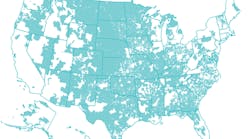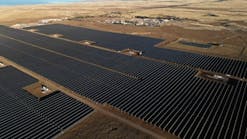Rural cooperatives are hard at work, discovering how their members can benefit from the Empowering Rural America Program (New Era). Funded by the Inflation Reduction Act (IRA), the U.S. Department of Agriculture is offering rural electric cooperative utilities and stakeholders a total of $9.7 billion renewables-focused grants and loans exclusively for rural electric cooperatives to purchase renewable energy, renewable energy systems, zero-emission systems and carbon capture and storage systems, with grants covering no more than 25% of the project cost, under IRA section 22004. The application window and runs through Sept. 29.
Co-ops serve 56% of the country’s landmass, including more than 90 percent of counties experiencing persistent poverty according to a The National Rural Electric Cooperative Association (NRECA) report. And in June 2023 the University of Wisconsin Center for Cooperatives, reported, rural electric cooperative system has grown to more than 800 distribution cooperatives, delivering electricity to 12 percent of electricity consumers in the United States via 42 percent of the country’s distribution lines. These 800 distribution cooperatives are served by 63 generation and transmission cooperatives (G&Ts), which generate around 5 percent of the nation’s electricity and own 6 percent of its transmission lines.There are several provisions that can help electric cooperatives bring affordable clean energy to rural communities across the country. Our research team at University of California, Berkeley has been studying the cost-saving impact the IRA can have for 11 of medium and large US generation and transmission (G&T) cooperatives, if they take advantage of IRA clean energy tax credits, along with new funding to guarantee loans for refinancing fossil assets. Our comprehensive report was released in June 2023.
The 11 Cooperative Utilities
The 11 G&Ts we analyzed make up a representative cross-section of the 63 G&Ts in the U.S. The selected B&Ts are Basin Electric Cooperative, Big Rivers Electric Corporation, Buckeye Power, Inc., Dairyland Power Cooperative, Great River Energy, Oglethorpe Power Corporation, Old Dominion Electric Cooperative, San Miguel Electric Cooperative, Inc., Seminole Electric Cooperative, Inc., Tri-State G&T Association, Inc., and Wabash Valley Power Association. Their service territories are shown in Figure 1.
Map of rural electric utilities assessed in this study.Rural cooperatives have been working to transition to clean energy across the country, with the share of renewable energy increasing from 17% of generation in 2016 to 22% of generation in 2021. Simultaneously, cooperatives’ coal-fired generation decreased to 32 percent of generation in 2021 from 41% in 2016. However, the cooperative transition from coal lags the rest of the country — nationwide, only 22% of electricity came from coal in 2021. Within G&Ts, coal resources are highly concentrated in just 16 cooperatives owning 85% of the 17 gigawatts of coal capacity still unannounced for retirement. Furthermore, while carbon dioxide emissions from cooperatives decreased from nearly 200 to 165 million tons in 2021, natural gas generation increased in share to 29% in 2021 from 26% in 2016.
Our research team employed Regional Energy Deployment System (ReEDS) model developed by the National Renewable Energy Laboratory (NREL), an industry-standard optimal capacity expansion model, and using several simplifying assumptions, forecast a least cost electricity resource mix for the eleven G&Ts described above for 10 years, from 2022 through 2032. We then use PLEXOS, another industry standard production cost simulation model toevaluate hourly dispatch at the individual power plant level for the year 2032 to ensure that the electricity resource mix is technically and operationally feasible and is able to meet demand with generation throughout the year, including periods of high demand and low RE generation. The analysis was conducted without considering the New Era grants and financing available. Additional details could be found in our June 2023 Report.
What are the Opportunities?
With direct-pay tax credits and New ERA, cooperatives can own the transition and pass the benefits of reliable clean energy portfolios to their members and communities. We find four key results:
First, the least-cost electricity generation portfolio for rural electric cooperatives, if all coal generation is retired by 2032, includes 80 to 90% clean electricity and reduces wholesale electricity costs by 15 to 20% on average compared to 2022. Declines in renewable energy and storage costs, IRA incentives, and the availability of high-quality solar and wind power in rural cooperative service territories are key drivers of wholesale cost savings.
Second, due to the deployment of batteries, the reserve margin of most utilities substantially increases from approximately 15 to 20% below peak load on average in 2022 to approximately 15 to 20% above peak load in 2032, even as all coal retires. Greater self-reliance also reduces the need for purchases on the wholesale market from about 40 percent in 2022 to about 15 to 20% in 2032.
Third, G&Ts can leverage the excellent renewable resource potential in their regions to directly own resources and invest in their member cooperatives, with up to $80 billion in investment between the 11 utilities. Half of this investment could be offset by IRA tax credits, and loans and grants from the New ERA program could further reduce utilities’ debt exposure. For cooperative utilities investing up to $4 billion in clean energy, the combination of tax credits and the New ERA program could pay down up to 80 percent of clean energy project costs.
Fourth, with significant investments in battery storage and a good correlation between wind and solar resources with load, utilities will be capable of meeting the load requirements at all hours of the year, including periods of peak load and low renewable generation.
These findings show that the IRA, via tax credits and funding from the New ERA program, has created a window of opportunity for rural America—one that can increase economic standing while reducing carbon emissions. While the tax credits will be available for the next 10 years, rural utilities should act now to take advantage of the $9.7 billion available through New ERA to maximize savings and member-owned assets.
What Could Emissions Look Like in 2032?
The cost-effectively of leveraging IRA incentives including New ERA grants and financing for wind, solar, and storage are more fully discussed in our June 2023 Report.
Cost-effective investment in new clean energy resources would drastically reduce carbon pollution for all 11 cooperative utilities we examined – 90% on average by 2032. Clean energy investments replace all coal generation and significantly reduce reliance on gas for generation, even as existing gas capacity remains to bolster reliability, with clean energy reaching 80 to 90% of total generation serving these utilities. Similar studies have found reduced coal and gas generation would also markedly reduce air pollution in nearby communities resulting in improved public health, though to what degree was beyond this analysis.
In addition to the environmental benefits, reducing carbon emissions would de-risk cooperative utilities that are facing tightening pollution rules from the U.S. Environmental Protection Agency (EPA) and reduced market appetite for their coal plants. The EPA is working on at least seven rules that would affect power sector pollution: carbon standards for new and existing plants, Mercury and Air Toxics Standards, a national soot standard, national smog standards, toxic water pollution rules, the Regional Haze Rule, coal ash rules, and the Good Neighbor rule. In addition, member cooperatives are increasingly adopting carbon goals of their own and trying to extricate themselves from must-take contracts that involve expensive coal power. For example, several member distribution cooperatives in Tri-State have attempted to leave the cooperative due to high coal power prices. Moving toward lower-emissions sources would insulate G&Ts from both environmental and member defection risks. Finally, new clean energy investments promise significant new local job opportunities, outweighing the job losses due to coal plant closures, albeit with worker retraining. Additionally, because existing gas power capacity is found to be cost-effective for maintaining the grid reliability, gas power plant jobs are unlikely to be affected.
Seizing the Opportunity
Our analysis shows taking advantage of the IRA opportunity can achieve three goals:
- Promote rural development, job creation, and investment
- Lower costs for consumers
- Reduce pollution and GHG emissions
The New ERA program and direct-pay tax credits offer a unique opportunity for rural electric cooperatives to become America’s clean energy leaders, boosting rural economic development and lowering costs to members. These 11 electric cooperatives – and likely others like them – can acquire clean energy to meet growing load and reliability obligations and still retire their coal plants by decade’s end. The federal incentives offered to rural cooperatives—rivaled in scope only by the New Deal electrification program—hold the promise to modernize energy systems in rural America. These investments can be the start of an energy-centric development strategy that embraces new energy sources and revitalizes communities that need it.
Dr. Nikit Abhyankar is a senior scientist at the Center for Environmental Public Policy of the University of California, Berkeley. He also serves as a Guest Faculty for the executive education program at University of California, Berkeley. His research focuses on a range of key energy issues such as renewable energy, energy efficiency, electric vehicles, and energy access in the United States and other key economies such as India, China, Japan, Korea, Indonesia, and Vietnam. He regularly advises national / state governments, regulators, and utilities in multiple countries on designing clean energy policies and programs. Nikit has published over 60 journal articles, research reports, and conference papers, and his research has been widely covered in the media. Nikit has a Ph.D. in Environment and Resources from Stanford University.
Dr. Amol Phadke is a senior scientist at the Goldman School of Public Policy, University of California, Berkeley. Currently, his work is focused on grid scale battery storage, heavy-duty electric vehicles, deep RE penetration in the India power sector, and appliance and equipment efficiency in several emerging economies. Amol has published over 80 journal articles, research reports, and conference papers. His work has been featured in numerous other publications. Amol regularly advises the national government, utilities, and regulators on energy policies and programs. Amol has a Bachelor of Engineering degree from Government College of Engineering, Pune, India, and a M.S. and Ph.D. from the Energy and Resources Group, from UC Berkeley.
Umed Paliwal is a senior scientist at the Goldman School of Public Policy, University of California, Berkeley. He conducts research on ways to integrate high share of renewables on the grid and its impact on reliability and electricity prices. He holds a Master of Public Policy from UC Berkeley and did his undergraduate studies in Civil and Environmental Engineering from Indian Institute of Technology Kanpur (India).



